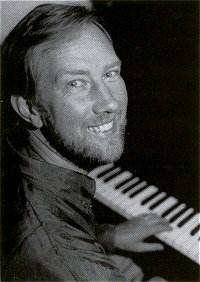
Tall Poppies is an Australian label, devoted principally to
the work of musicians from that continent. Roy Howat is Scottish,
married to the Australian composer, Wendy Hiscocks, and spends
a significant amount of time in Australia teaching, lecturing
and playing. Tall Poppies embarked on this project because they
considered that Howat’s Debussy was so different to any they had
heard before and ‘fit into what [they] consider an Australian
ethos of performance, which is sort of an antipodean view of the
world which sometimes brings new insights into European classical
music.’ He is an outstanding pianist, and it is exciting to have
his four volume Debussy series now complete.
Howat is not only a fine pianist; he is also
a considerable Debussy scholar, having contributed a book to the
literature – Debussy in Proportion – plus numerous articles.
He is also an editor of the Paris-based Complete Debussy Edition,
so he is truly immersed in this music. The result is that
his playing has a tangible sense of authority, easily sensed from
the very first track of each CD.
He has also contributed the exemplary and extensive
booklet notes, and it is gratifying to see research and performance
interacting in such a creative and intelligent way. One specific
example; Howat has noted from Debussy’s own piano roll performance
(and other sources) that part of the famous prelude La cathédrale
engloutie is printed in note-values of twice the intended
duration, and has adapted his performance accordingly. This interests
me, in that I had always felt that this piece, wonderful though
it is, dwarfed the other preludes, being more than twice the length
of most of them, and, listening to Howat's reading, it makes perfect
musical sense to do as he has done.
A characteristic of Debussy’s that comes over
surprisingly strongly in this set is his humour. It’s there not
only in such obviously comical numbers such as Général
Lavine – excentrique, or Hommage à S.Pickwick esq.,
P.P.M.P.C, but also, more subtly, in the allusions to other
music, such as Handel, Bach and Daquin, all hinted at in quick
succession in the finale of Pour le piano. Titles are often
deliciously witty too; the lovely La plus que lent, almost
impossible to translate, but meaning something like ‘The slowest
of them all’ was a wry comment on the fashion for very slow waltzes;
while the romantic sounding Les soirs illuminés par
l’ardeur du charbon – ‘Evenings lit up by the glowing of coal’
- despite being a quotation from Baudelaire, simply reflects the
fact that, in the bitterly cold, war-torn Paris winter of 1917,
Debussy received a welcome delivery of coal from a local merchant,
then wrote the work as a ‘thank-you’.
That piece, receiving its first ever recording,
is just one of the numerous rarities which are liberally sprinkled
amongst the more famous works. Some are of little consequence,
but some are well worth hearing. Vol.2, for example, contains
the extraordinary Berceuse héroïque of 1914,
a powerful and gloomy work, written in the very early days of
the Great War. It has a subtly understated march-like tread, ad
its progress is marked by disembodied fanfares. That is followed
by the Page d’album, donated to support the work of an
organisation called Le vêtement du blessé (The
dressing of the wounded), which Howat describes as ‘an exquisite
little waltz’, and an interesting Elégie. This would
make a good one for a ‘blind’ listening session with friends.
The name of George Gershwin is sure to come up much sooner than
Debussy’s, as it’s full of lovely jazzy ‘squelches’, and the sort
of textures Gershwin employed so effectively in his Preludes.
Volume 1 contains the two sets of Images,
between which are the two books of Etudes, plus an
Etude retrouvée, another of Howat’s discoveries.
The first series of Images is arguably where Debussy emerged
in his full greatness as a composer for the piano, and the first
movement, Reflets dans l’eau, immediately makes manifest
Howat’s qualities as a pianist. Here are brilliance and technical
bravado in generous measure, but also the greatest sensitivity
to the voicing of the music, meaning that there is a transparency
to his playing that allows one to hear everything with the greatest
clarity. Far from losing the sense of mystery, this actually enhances
it, and I don’t remember this music ever sounding more ravishingly
beautiful. The central Hommage à Rameau, a delicately
sad sarabande, has great dignity and restraint, while the pulsating
final Mouvement is powerfully motoric.
Then comes the first book of Etudes, in
which Debussy, like Chopin before him, uses technical issues as
a ‘camouflage’ for intensely poetic music. Here, as in the second
book, Howat is an ideal interpreter, making no concessions to
the often acute difficulties of the music, yet catching the character
of each piece superbly. There isn’t the space to go through all
of these; to take one example almost at random, listen to track
6, Pour les quartes (‘For fourths’), in which little bursts
of pentatonic orientalism alternate with darker, whole-tone sounds,
building up an incredibly rich and allusive tonal picture. And
all this so as to practise those nice smooth 4ths! The disc ends
with the second series of Images. Here again, Howat is
immensely disciplined, so that the precise imagery of the first
movement, the wonderful Cloches à travers les feuilles
(‘Bells across the leaves’) is etched out clearly, with no
blurring of the rhythmic outlines. In his notes, Howat reminds
us of Debussy’s insistence, no doubt with errant pianists in mind,
that his music must be played "exactly in time".
Volume 2 features Book 2 of the Préludes,
the early Images oubliées, and the three short
‘war effort’ pieces described earlier. It concludes with an ‘unofficial’
suite, the ‘2nd Suite Bergamasque’ whose inclusion
in this form Howat justifies by explaining how the three pieces
contained within it were undoubtedly intended as a triptych, even
though they were never published as such. It’s a fascinating story,
far too long to recount here, but quite convincing given the circumstances,
and totally born out by the musical result. The final piece is
L’isle joyeuse – ‘Island of joy’, a semi-autobiographical
reference to Jersey, where Debussy had eloped with his mistress
Emma Bardac . This is surely one of the composer’s high
points, a thrilling tour de force. Howat flings himself
at this piece in an uninhibited way that captures the spirit of
a live performance, building through the final sequence of key-changes
to a climax which is only equalled in the composer’s music – not
surpassed – by the ending of La Mer. This is inspired,
seat-gripping stuff. The Préludes receive equally
splendid treatment, with Howat excelling in the rustling textures
of Feuilles mortes (‘Dead leaves’) and, at the other extreme,
the jagged explosions of Feux d’artifices (‘Fireworks’).
Volume 3 contains the Estampes, the first
book of Préludes, the suite Pour le piano,
and a number of shorter pieces. These are Les soirs illuminés
par l’ardeur du charbon described above; the tiny Morceau
de concert; the delightful ragtime Le petit Nigar;
the witty trifle Hommage à Haydn, in
which the eponymous composer’s name is ‘spelt out’ in the musical
notation, and, concluding the disc, the wonderful La plus que
lente. The Préludes are given performances
as imaginative as those of Book 2 on the previous disc, with
tempi that are often surprising on first hearing, but which always
make perfect expressive sense. The first one, Danseuses de
Delphes, is a perfect example – just a shade more flowing
than usual so that the music does indeed dance, with the sustaining
pedal used sparingly.
Volume 4 contains some of those early pieces
which, perversely, sustain Debussy’s popular reputation; the Arabesques,
the Suite bergamasque (which of course contains Claire
de lune), and THAT Rêverie! Howat plays all of
these, as well as the delightful Children’s Corner, as
though they’d never been recorded before, and they do indeed come
up sounding quite fresh - though I confess I don’t much care for
Howat’s over-emphatic articulation of the triplets in the first
Arabesque.
This is a truly distinguished set of Debussy
recordings, worthy, in my view, to take their place amongst the
very finest on disc. Not only do they throw much new light on
very celebrated music, they also contain much which is hard to
find recorded anywhere else. Above all, there is sensitivity and
vibrant imagination, allied to a transcendental technique always
at the service of the music. The recording is so good that I didn’t
even notice it – believe me, that is a sincere compliment, particularly
where piano recordings are concerned! These discs are yet another
indication of the great music-making with which Australia abounds
these days.
Gwyn Parry-Jones
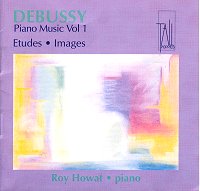
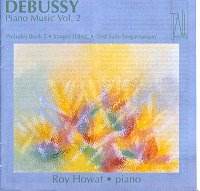
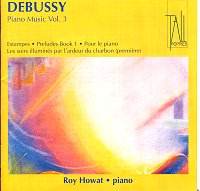
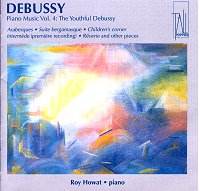
![]() Roy Howat, piano
Roy Howat, piano
![]() TALL POPPIES TP094,
TP123, TP164, TP165 Vol 1: [79:00] Vol 2: [71:38] Vol 3: [74:44] Vol
4: [73:04]
TALL POPPIES TP094,
TP123, TP164, TP165 Vol 1: [79:00] Vol 2: [71:38] Vol 3: [74:44] Vol
4: [73:04] 